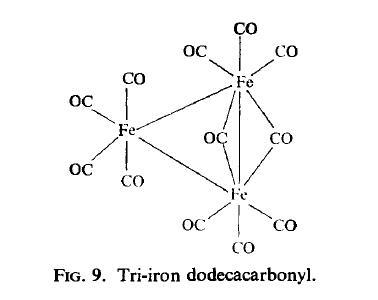| Identification | Back Directory | [Name]
IRON DODECACARBONYL | [CAS]
12088-65-2 | [Synonyms]
IRON DODECARBONYL
IRON DODECACARBONYL
TRIIRON DODECACARBONYL
5-10%methanolstabilized
TRIIRON(0) DODECACARBONYL | [EINECS(EC#)]
241-668-5 | [Molecular Formula]
C12Fe3O12 | [MDL Number]
MFCD00135617 | [MOL File]
12088-65-2.mol | [Molecular Weight]
503.66 |
| Chemical Properties | Back Directory | [Melting point ]
165 °C (dec.)(lit.)
| [density ]
2.0000 | [storage temp. ]
2-8°C
| [form ]
black crystals | [color ]
dark green crystals, crystalline |
| Hazard Information | Back Directory | [Chemical Properties]
stabilized with 5%–10% methanol; black crystal(s); sensitive to air [STR93] | [Preparation]
Tri-iron Dodecacarbonyl was first obtained by thermal decomposition of non aqueous solutions
of the enneacarbonyl at 100°C :
6Fe2(CO)9 -> 2Fe3(CO)12+6Fe(CO)5
but is now usually prepared from solutions of carbonylferrate anions. One method uses
the oxidation of these ions with manganese(IV) oxide followed by acidification and extraction
of the carbonyl into petroleum ether. In another method,iron pentacarbonyl
is treated with aqueous triethylamine to form the dark red [Et3NH][Fe3(CO)11H] which is
then acidified and the carbonyl extracted into petroleum ether. | [Structure and conformation]
The structure of Fe3(CO)12 (Fig.9) is related to that of Fe2(CO)9 in that it can be
described as a triangular metal cluster in which one bridging group of the Fe2(CO)9 system is replaced by an Fe(CO)4 group. This X-ray data is in agreement with the M?ssbauer
spectrum which shows the presence of two types of iron atom ; two of the iron atoms
show substantial quadrupole splitting and have isomer shifts similar to those of the iron
atoms in Fe2(CO)9, while the other iron atom shows little splitting as might be expected for
an octahedral environment. A similar structure is possessed by the [Fe3(CO)11H] anion in
which one of the bridging carbonyl groups is replaced by a bridging hydrogen atom.
 |
|
| Company Name: |
Ereztech LLC
|
| Tel: |
1.888.658.1221 |
| Website: |
www.ereztech.com |
| Company Name: |
Cardinal Industries
|
| Tel: |
1.414.358.1214 |
| Website: |
www.chemicalbook.com/ShowSupplierProductsList8408/0_EN.htm |
|